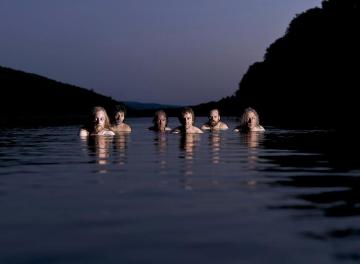
RAILROAD EARTH- MISSOULA
Details
There’s a great scene in The Last Waltz – the documentary about The Band’s final concert – where director Martin Scorsese is discussing music with drummer/singer/mandolin player Levon Helm. Helm says, “If it mixes with rhythm, and if it dances, then you’ve got a great combination of all those different kinds of music: country, bluegrass, blues music, show music…” To which Scorsese, the inquisitive interviewer, asks, “What’s it called, then?”
“Rock & roll!”
Clearly looking for a more specific answer, but realizing that he isn’t going to get one, Marty laughs. “Rock & roll…”
Well, that’s the way it is sometimes: musicians play music, and don’t necessarily worry about where it gets filed. It’s the writers, record labels, managers, etc, who tend to fret about what “kind” of music it is.
And like The Band, the members of Railroad Earth aren’t losing sleep about what “kind” of music they play – they just play it. When they started out in 2001, they were a bunch of guys interested in playing acoustic instruments together. As Railroad Earth violin/vocalist Tim Carbone recalls, “All of us had been playing in various projects for years, and many of us had played together in different projects. But this time, we found ourselves all available at the same time.”
Acoustic guitar/lead vocalist Todd Sheaffer continues, “When we started, we only loosely had the idea of getting together and playing some music. It started that informally; just getting together and doing some picking and playing. Over a couple of month period, we started working on some original songs, as well as playing some covers that we thought would be fun to play.” Shortly thereafter, they took five songs from their budding repertoire into a studio and knocked out a demo in just two days. Their soon-to-be manager sent that demo to a few festivals, and – to the band’s surprise – they were booked at the prestigious Telluride Bluegrass Festival before they’d even played their first gig. This prompted them to quickly go in and record five more songs; the ten combined tracks of which made up their debut album, “The Black Bear Sessions.”
That was the beginning of Railroad Earth’s journey: since then, they’ve released three more studio albums, two on Sugar Hill Records (2002’s “Bird In A House” and 2004’s “The Good Life”) and one on SCI Fidelity (2008’s “Amen Corner”). They’ve also amassed a huge and loyal fanbase that follows them from show to show, taking advantage of the band’s liberal taping policy. But RRE bristle about being lumped into any one “scene.” Not out of animosity for any other artists: it’s just that they don’t find the labels very useful. As Carbone points out, “We use unique acoustic instrumentation, but we’re definitely not a bluegrass band – so that doesn’t fit. And I think the term ‘jam bands’ probably refers more to the fans than to the bands. I think these fans just like live music.”
Railroad Earth certainly thrives in a live setting, as their stunning 2006 live album, “Elko,” is certian proof of that. It’s no secret that improvisation is one of the RRE’s big strengths. But what really sets them apart is the strength of their songwriting. It was the strength of those first five songs that got them on the bill at Telluride. And they’ve only gotten better since then.
Indeed, Railroad Earth’s music is driven by the remarkable songs of front-man, Todd Sheaffer, and is delivered with seamless arrangements and superb musicianship courtesy of all six band members. As mandolin player John Skehan points out, “Our M.O. has always been that we can improvise all day long, but we only do it in service to the song. There are a lot of songs that, when we play them live, we adhere to the arrangement from the record. And other songs, in the nature and the spirit of the song, everyone knows we can kind of take flight on them.” Sheaffer continues: “The songs are our focus, our focal point, they give the improvisation a starting point. The jams sort of ‘comment’ on the songs, and give them color. Some songs lend themselves to improvisation. They ‘want’ to be approached that way – where we can explore and trade musical ideas and open them up to different territories. But sometimes it is what the song is about.”
When the band does elect to “comment” on a song via an extended improvisation, they really cook – and have received the approval of no less than Grateful Dead bass player Phil Lesh, who knows a thing or two about jamming. In fact, Mr. Lesh even used the RRE members as the “Friends” in his Phil & Friends band, and learned to play some of RRE’s repertoire, blowing the group’s collective mind.
So: they can jam with the best of them, but they’re not a jam band. They’re bluegrass influenced, but they use drums and amplifiers (somewhat taboo in the bluegrass world). What kind of music is it then? Mandolin/vocalist John Skehan offers this semi-descriptive term: “I always describe it as a string band, but an amplified string band with drums.” Tim Carbone takes a swing: “We’re a Country & Eastern band! ” Todd Sheaffer offers “A souped-up string band? I don’t know. I’m not good at this.” Or, as a great drummer/singer/mandolin player with an appreciation for Americana once said: “Rock & roll!”